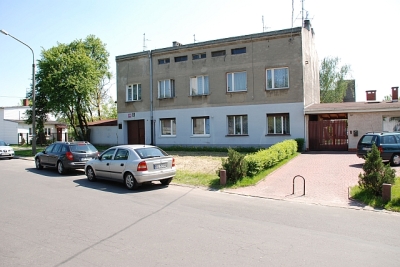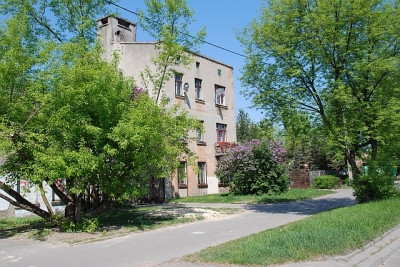This was the northeastern part of the ghetto, where many wooden houses, previously inhabited mainly by Poles, were located. A large segment of the area was made up of fields, gardens and cottages. For the ghetto inhabitants, Marysin was a symbol of well-being. Here, there were vacation homes for the favored officials and what functioned as summer apartments for some of the Jewish administrations dignitaries. However, special centers for Zionist youth, the so-called hakhsharas, where young people learned to cultivate the fields, were situated here as well. Plots of land managed by various youth organizations also marked the area. There were more than 20 kibbutzim, with well over 1,000 people involved. The kibbutzim were also involved in cultural and educational activities.
 The Central Managing Office of Marysin II was located at 5 Prozna St.
In the first months of the ghetto operation, the Marysin area had orphanages (100 Marysinska St. and 119 Okopowa St.), schools (48 Marysinska St.), along with summer camps and day camps for children from that were established June 11, 1941. The day camps were organized especially for poor children and orphans. The camps for children were held mainly in the summer, but also at other times of the year. The children lived in boarding houses, where they were learning and working. More than 100,000 children attended the camps. Many photographs have been retrieved that show the children playing in the fields of Marysin.
The Central Managing Office of Marysin II was located at 5 Prozna St.
In the first months of the ghetto operation, the Marysin area had orphanages (100 Marysinska St. and 119 Okopowa St.), schools (48 Marysinska St.), along with summer camps and day camps for children from that were established June 11, 1941. The day camps were organized especially for poor children and orphans. The camps for children were held mainly in the summer, but also at other times of the year. The children lived in boarding houses, where they were learning and working. More than 100,000 children attended the camps. Many photographs have been retrieved that show the children playing in the fields of Marysin.
 The Summer Camps Office and the Section of Children’s Soup Kitchens were located at 23 Zagajnikowa St. In September 1942, during the so-called "shpera" the children from the summer camps were deported to the death camp at Chelmno-nad-Nerem, along with several thousand other young inhabitants of the ghetto, and killed. Later, these buildings were occupied by various departments.
The Summer Camps Office and the Section of Children’s Soup Kitchens were located at 23 Zagajnikowa St. In September 1942, during the so-called "shpera" the children from the summer camps were deported to the death camp at Chelmno-nad-Nerem, along with several thousand other young inhabitants of the ghetto, and killed. Later, these buildings were occupied by various departments.
Today, the Marysin area looks completely different from the war era. Some of the buildings survived, but the vegetable fields are gone. Houses and apartment complexes now dot the area.
Mr. Chairman, who stayed in Marysin on Saturday afternoon, made an inspection of the children from the summer camp. Troops of children led by their tutors marched lively past the Eldest of the Jews.
The Chronicle of the Lodz Ghetto, July 13-15, 1941, Vol. 1, p. 197.
We had no classes because all children staying in Marysin were to march in front of Rumkowski, and, what's most important, we got an additional afternoon snack:
a piece of bread with a slice of sausage. Indeed, a lordly gesture of our master! Of course, a speech couldn't be avoided. The old man said that he gives us what he can and, in return, he demands from us to learn, learn and learn well.
Dawid Sierakowiak, Diary, July 27, 1941, p.43.
The ghetto is developing better and better. A large number of workshops and factories is being established, and together with the old one they indeed constitute what they jokingly call '/1 Jewish Industrial District." Marysin, a completely separate district, houses not only schools, summer camps, sanatoriums, etc., but also many factories and labor departments, like the workshop producing carpets from rags, a marmalade factory, candy factory, a shoemakers' workshop, ornament workshop and many others. It is all "state-owned" or "des Aeltesten der Juden" [supervised by the Eldest of the Jews].
Dawid Sierakowiak, Diary, August 24, 1941, p. 49.
Above all, the Chairman was determined to invite as many workers as possible to his place in Marysin for a regular holiday. And so he did. Every week another group of ''distinguished'' managers, trusted people and reliable friends would go to the house in Marysin; they would go on foot, sometimes by horse carriage, and later also by tram to the Eldorado of the ghetto, to the Chairman's house (119 Okopowa St.), in order to relax from the nerve-racking everyday work in the ghetto. It was the Chairman's wish that the vacationers not be visited by any relatives during that short holiday. And indeed, this was a rest! It's amazing how much this week has done for us. It is only a few minutes away from the city center, but it is a completely different world. The landscape of Marysin, gloomy and not delightful in itself, as was the entire area, would turn into a paradise for the vacationers.
Oskar Singer, Walking Quickly through the Ghetto, p. 114.
Two years ago, the Chairman established a rest house (Heim) for high-ranking dignitaries in Marysin. The lodging period was scheduled for seven days. The first groups consisted of the highest-ranking dignitaries and people closest to Rumkowski's heart. They were fed well. The population started protesting against such injustice; those who are allotted the best food rations and even get special coupons from the Chairman do not need any better food, the more so because the first groups included people whose work was not exhausting, for they did not do anything. Under pressure from public opinion, they started to send to Heim other officials as well, such as office advisers, clerks, etc. Those were, however, still the privileged people. Only at the end of the summer of 1942, new Heims were set up for the workers, and workers from the departments were beginning to be sent there in large groups. At present, four Heims are functioning: two for officials and two for workers. People are sent there all year round, but those who suffered from abdominal typhus have priority.
Jakub Poznanski, March 7, 1943, p. 50

 Home
Home
